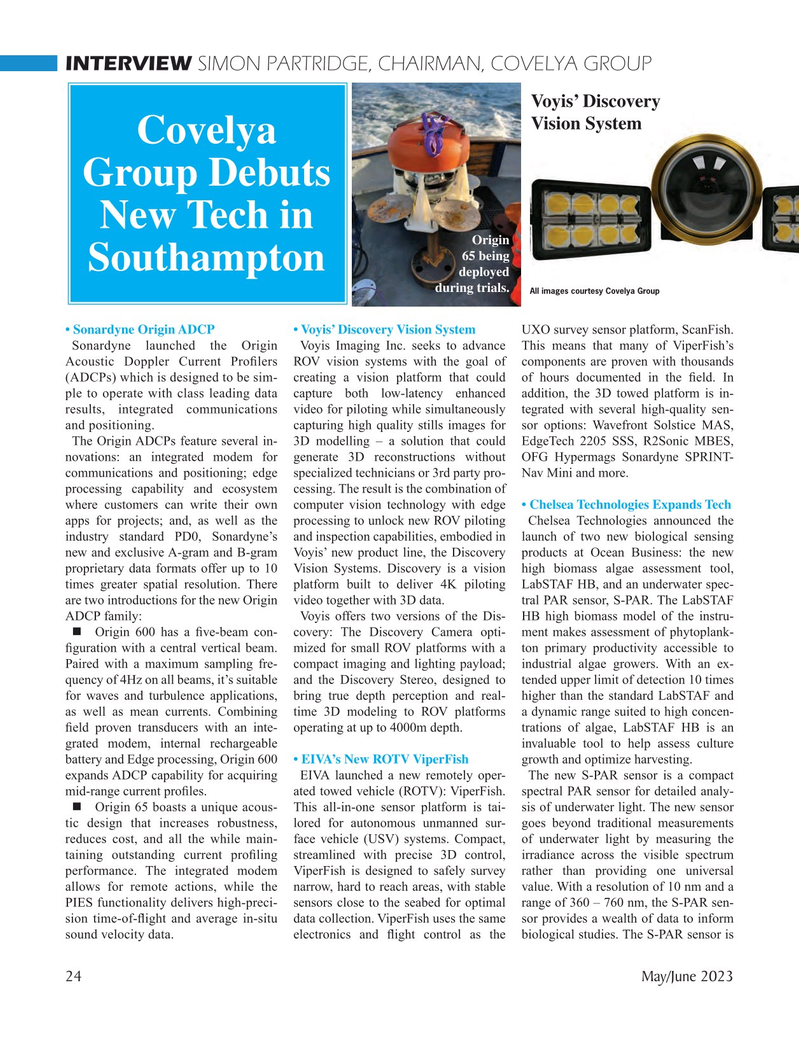
Page 24: of Marine Technology Magazine (May 2023)
Read this page in Pdf, Flash or Html5 edition of May 2023 Marine Technology Magazine
INTERVIEW SIMON PARTRIDGE, CHAIRMAN, COVELYA GROUP
Voyis’ Discovery
Covelya
Vision System
Covelya
Group Debuts
Group Debuts
New Tech in
New Tech in
Origin
Southampton 65 being
Southampton deployed during trials.
All images courtesy Covelya Group • Sonardyne Origin ADCP • Voyis’ Discovery Vision System UXO survey sensor platform, ScanFish.
Sonardyne launched the Origin Voyis Imaging Inc. seeks to advance This means that many of ViperFish’s
Acoustic Doppler Current Pro? lers ROV vision systems with the goal of components are proven with thousands (ADCPs) which is designed to be sim- creating a vision platform that could of hours documented in the ? eld. In ple to operate with class leading data capture both low-latency enhanced addition, the 3D towed platform is in- results, integrated communications video for piloting while simultaneously tegrated with several high-quality sen- and positioning. capturing high quality stills images for sor options: Wavefront Solstice MAS,
The Origin ADCPs feature several in- 3D modelling – a solution that could EdgeTech 2205 SSS, R2Sonic MBES, novations: an integrated modem for generate 3D reconstructions without OFG Hypermags Sonardyne SPRINT- communications and positioning; edge specialized technicians or 3rd party pro- Nav Mini and more. processing capability and ecosystem cessing. The result is the combination of where customers can write their own computer vision technology with edge • Chelsea Technologies Expands Tech apps for projects; and, as well as the processing to unlock new ROV piloting Chelsea Technologies announced the industry standard PD0, Sonardyne’s and inspection capabilities, embodied in launch of two new biological sensing new and exclusive A-gram and B-gram Voyis’ new product line, the Discovery products at Ocean Business: the new proprietary data formats offer up to 10 Vision Systems. Discovery is a vision high biomass algae assessment tool, times greater spatial resolution. There platform built to deliver 4K piloting LabSTAF HB, and an underwater spec- are two introductions for the new Origin video together with 3D data. tral PAR sensor, S-PAR. The LabSTAF
ADCP family: Voyis offers two versions of the Dis- HB high biomass model of the instru- ? Origin 600 has a ? ve-beam con- covery: The Discovery Camera opti- ment makes assessment of phytoplank- ? guration with a central vertical beam. mized for small ROV platforms with a ton primary productivity accessible to
Paired with a maximum sampling fre- compact imaging and lighting payload; industrial algae growers. With an ex- quency of 4Hz on all beams, it’s suitable and the Discovery Stereo, designed to tended upper limit of detection 10 times for waves and turbulence applications, bring true depth perception and real- higher than the standard LabSTAF and as well as mean currents. Combining time 3D modeling to ROV platforms a dynamic range suited to high concen- ? eld proven transducers with an inte- operating at up to 4000m depth. trations of algae, LabSTAF HB is an grated modem, internal rechargeable invaluable tool to help assess culture battery and Edge processing, Origin 600 • EIVA’s New ROTV ViperFish growth and optimize harvesting.
expands ADCP capability for acquiring EIVA launched a new remotely oper- The new S-PAR sensor is a compact mid-range current pro? les. ated towed vehicle (ROTV): ViperFish. spectral PAR sensor for detailed analy- ? Origin 65 boasts a unique acous- This all-in-one sensor platform is tai- sis of underwater light. The new sensor tic design that increases robustness, lored for autonomous unmanned sur- goes beyond traditional measurements reduces cost, and all the while main- face vehicle (USV) systems. Compact, of underwater light by measuring the taining outstanding current pro? ling streamlined with precise 3D control, irradiance across the visible spectrum performance. The integrated modem ViperFish is designed to safely survey rather than providing one universal allows for remote actions, while the narrow, hard to reach areas, with stable value. With a resolution of 10 nm and a
PIES functionality delivers high-preci- sensors close to the seabed for optimal range of 360 – 760 nm, the S-PAR sen- sion time-of-? ight and average in-situ data collection. ViperFish uses the same sor provides a wealth of data to inform sound velocity data. electronics and ? ight control as the biological studies. The S-PAR sensor is 24 May/June 2023
MTR #4 (18-33).indd 24 6/1/2023 11:48:32 AM

 23
23

 25
25
